When one hears the word “Pinkville,” one imagines a cute, quaint village, right? However, the real Pinkville is the exact opposite of this perception. Pinkville was a term U.S. soldiers coined the Vietnamese village of My Lai, where one of the most inhumane moments of the Vietnam War happened. Blood, rape, and the screams from the brutal murder of children, women, and elderly are burned into our minds when we envision the My Lai Massacre in 1968.1
The Vietnam War began in 1954 when communist leader Ho-chi-minh defeated the French, who had colonized Vietnam in 1887. North and South Vietnam battled over their new government, as South Vietnam desperately tried to resist communist control. Amidst the heat of the Cold War between America and the Soviet Union, and afraid that communism would spread throughout Southeast Asia, the U.S. government ordered military involvement in 1964. The U.S. drafted healthy men age 18 or older to fight the war in Vietnam. Being a soldier stationed in Vietnam at this time came with immense stress. Spread thin, American soldiers were stationed in Vietnam for double the time a soldier was normally deployed, and they were only allowed a one month break, adding to this high amount of tension. There, soldiers saw incredibly brutal things daily — children were often used as weapons by the Vietnamese army and the language barrier made it incredibly hard to distinguish between friend and enemy. One soldier described their encounter with “gooks,” an extremely derogative term for Southeast Asians, “At first there was some confusion. How did you tell gooks from the good Vietnamese, for instance? After a while it became clear. You didn’t have to. All gooks were [Vietnamese Communist] when they were dead.”2 U.S. soldiers developed paranoia, and although the exact reason why the U.S. Commanders ordered the massacre is not known, one can presume it was due to the uneasy situation between the U.S. soldiers and the Vietnamese, which also led to the brutality at Pinkville.3
The U.S. military believed that Pinkville was booby-trapped to the extreme, and it was unknown whether or not the residents supported the Vietnamese communists, also referred to as Vietcong. Because of this, an order was placed by the Charlie Company — a unit of the U.S. Army American Division — to destroy all of the village inhabitants, and to leave no survivors. This order led to the most brutal and controversial massacre of the U.S. Army’s history. After the order was placed, the My Lai massacre was led by Lieutenant William Calley, followed by another Charlie Company unit, and it involved the vicious murder and rape 300 to 500 of women, children, and elderly civilians.4However, this dark moment in history remained a secret. It was not revealed to the U.S. public or even the U.S. government until months after the event had taken place.
Ron Ridenhour, a U.S. soldier who was serving in Vietnam at the time, played a central role in exposing the events that happened in the previously peaceful village of My Lai. Ridenhour was a helicopter gunner that had been drafted to the army at the same time as a man named Mike Terry. There, they became close friends, separated only once to different divisions when Terry was assigned to Lt. Calley’s platoon. That one separation caused a major change in Terry when he and Ridenhour were eventually reunited after being assigned to the same unit. Previous to their separation, Ridenhour thought Terry to be the definition of innocence as Terry was firm in his religious beliefs. Ridenhour was hit with the shock of his life when Terry told him the events that occurred in My Lai.5

Ridenhour, although not present at the event, began to hear about the events that took place at My Lai from Terry.6 Although Terry only participated in mercy killings to eliminate those who were mortally wounded and prevent them from suffering further, shock and horror filled Ridenhour as he heard about the rest of the gruesome details. Ridenhour, in absolute disbelief, almost refused to believe the event occurred. Determined to uncover the truth, he then consulted numerous other soldiers, expecting denial of this brutality, but instead, the soldiers added more horrific information to the massacre that occurred that day. Spurred to action, Ridenhour wrote a letter to President Richard Nixon and thirty Congressmen about these findings. In his letter, he recounted the numerous statements he had heard from soldiers who were at this massacre. Ridenhour recalled one soldier’s encounter with a Vietnamese child about three or four years old, who had been shot in the arm, “The boy was clutching his wounded arm… while blood trickled between his fingers… He just stood there with big eyes staring around like he didn’t understand… Then the captain’s [radio operator] put a burst of M16 fire into him…”7 He continued to describe more encounters, and even recalled the story of a soldier who shot himself in the foot to get out of participating in the massacre. Further testimonies describe the “bayoneting, clubbing, and close-range shooting” of unarmed civilians.8 Ridenhour also described how the soldiers systematically lined up villagers along a ditch and fired into them, comparing it to the Holocaust.9 Angry that this event happened and dedicated to exposing these horrors to get justice, he urged the U.S. to pursue an investigation, and he ends the letter with the fact that he had considered sending this story to the reporters and newspapers to add pressure to the government to follow through with the investigation.10

After the investigation was exposed to the public, Ridenhour felt that the government “whitewashed” the event and wanted justice.11 With the help of a reporter named Seymour Hersh, they exposed the brutal event to the public, causing a rise of emotions globally. The massacre sparked controversy, disbelief, disgust, and anger in the public, especially among the American people. Ridenhour’s shock at even Terry’s involvement in the massacre mirrored the U.S. public’s shock as it unveiled the truth of what the Army and U.S. government were doing overseas. The My Lai Massacre became a turning point in the Vietnam War regarding U.S. involvement, leading many people to adamantly question if U.S. involvement in Vietnam was doing more harm than good. There had already been many protests against the involvement of the U.S. in the Vietnam War and against the draft targeting people of color. However, after Ridenhour exposed the massacre, protests increased exponentially among the American public. Eventually, these protests helped pressure the U.S. government to move troops out of Vietnam.12

Charges were brought up against thirty soldiers after the incident of My Lai was exposed, but only one person was convicted — Lieutenant Calley. Ridenhour believed the U.S. Army and the government used Calley as a scapegoat for all of the U.S. troops involved that day, since Calley was the lowest ranking officer leading this massacre. He was sentenced to life in prison, but due to the enormous amount of publicity regarding the massacre, it was deemed that his trial was unfair and too harshly affected by public view. His sentence was decreased to 20 years, and then to 10 years, after which President Nixon intervened and he served a three-year house arrest sentence.13
Although this massacre is shrouded in injustice for the hundreds of women, children, and elderly that lost their lives that day, Ridenhour and the few U.S. soldiers that risked their lives to go against orders and save as many Vietnamese civilians as possible represent those with true bravery and dedication to justice. Ron Ridenhour played a major role as the My Lai whistle blower, helping bring the truth of the injustice that happened to hundreds of innocent people in the village of My Lai to the public. Today, Ridenhour Prizes are awarded to journalists who follow Ridenhour’s example of being dedicated to truth telling in their writing and protecting social justice. These awards demonstrate the long-lasting importance of Ridenhour’s act of integrity and truthfulness.
- Donna Batten, “My Lai Massacre,” Gale Encyclopedia of American Law, 3rd ed., Vol. 7. (Detroit: Gale, 2010), 164-165. ↵
- Dan Duffy, and Tal Kali, The Viet Nam Generation Big Book (Woodbridge, Conn. : Viet Nam Generation Inc, 1994), 203-214. ↵
- Donna Batten, “My Lai Massacre,” Gale Encyclopedia of American Law, 3rd ed., Vol. 7. (Detroit: Gale, 2010), 164-165. ↵
- Ian Shapira, “‘It was Insanity’: At My Lai, U.S. soldiers slaughtered hundreds of Vietnamese women and kids,” Washington Post, March 16, 2018. ↵
- Dan Duffy, and Tal Kali, The Viet Nam Generation Big Book, (Woodbridge, Conn. : Viet Nam Generation Inc, 1994), 203-214. ↵
- Dan Duffy, and Tal Kali, The Viet Nam Generation Big Book, (Woodbridge, Conn. : Viet Nam Generation Inc, 1994), 203-214. ↵
- Lily Rothman, “Read The Letter That Changed the Way Americans Saw the Vietnam War,” Time Magazine, March 16, 2015. ↵
- Stephen L. Carter, “My Lai Revisited,” Newsweek, April 2, 2012, 19. ↵
- Ron Ridenhour, “Perspective on My Lai: ‘It was a Nazi kind of thing,'” Los Angeles Times, March 16, 1993. ↵
- Lily Rothman, “Read The Letter That Changed the Way Americans Saw the Vietnam War,” Time Magazine, March 16, 2015. ↵
- John H. Jr. Cushman, “Ronald Ridenhour, 52, Veteran Who Reported My Lai Massacre,” New York Times, May 11, 1998. ↵
- Donna Batten, “My Lai Massacre,” Gale Encyclopedia of American Law, 3rd ed., Vol. 7. (Detroit: Gale, 2010), 164-165. ↵
- Cynthia Rose, “Lieutenant Calley: His Own Story,” American Decades Primary Sources, Vol. 8, 1970-1979 (Detroit: Gale, 2004), 297-301. ↵



50 comments
Karla Cardenas
Learning more about one of America’s darkest times is always upsetting because it’s always “it gets worse” rather than anything good about that time period. Not to mention the charges on the Lieutenant weren’t fair since it didn’t even serve justice for the horrible events that happened, and it wasn’t fair that he was the scapegoat since the troops were just as responsible for what they did, and they should have all been held accountable. The writing in this article was great and it delivered the information well enough to understand.
Rhys Kennedy
It is always unsettling to hear about these types of subjects. It was really surprising to hear about how long this massacre went under the radar, but given the time period and technology that they had at the time, it becomes understandable. Media during the Vietnam War marked a turning point in the ability of the public to know what was going on elsewhere in the world. It is devastating to see that horrible events like these have to be turning points in history, but thanks to the actions of people like Ridenhour something can at least come of it.
Madeline Chandler
I very much enjoyed reading your article regarding North and South Vietnam with U.S. engagement. I have obviously previously heard of the Vietnam Wars yet I never knew the story of the massacre of My Lai. It was so devastating that such brutality was caused to civilians in the name of United States during war. You think of soldiers as brave men, yet those men weren’t brave just cowardice to commit so much sin. Vietnam experienced such transition, between defeating the French, from the power grab of North and South Vietnam, to the U.S. troops involving their power. This region experienced so much in such a short period of time and great tension for eras. Great job, I thoroughly enjoyed it!!
Mark Dominguez
A very thought-provoking article, it is bizarre to read about the horrendous incident that took place at the village of My Lai. It’s shocking to see the impact that the Vietnam War had on these soldiers, to move them do such horrific acts of violence. It takes a great amount of courage to do what Ridenhour did and speak up about this event.
Ruben Basaldu
This is such a dark story about an event that happened to innocent people. I did not know anything about this event but after reading this I wish that I could unread it not because the article is bad but because this is truly horrifying. I did not think that the U.S military would be capable of doing something like this but I guess I was wrong. I am glad that Ridenhour made the people aware of this event because who knows how long this would have been just under the radar.
Paola Arellano
This story is chilling and honestly, not told enough. I was unaware of this event, granted I am not from this era, but we learn about the Vietnamese War in school and never once is this mentioned. This type of massacre and action shows that war is terrible and in my opinion it is unnecessary. We have come too far as a society to be stooping down to levels of murdering other people to simply acquire what it is that we want. This not only goes for the United States but for the entire world. I am glad that Ridenhour spoke up about this situation and I cannot even imagine what was going through the soldiers’ heads. Did they really believe that those actions were for their country?
Scott Sleeter
Very well written article about a dark corner of American history. The introduction does a great job of grabbing attention and the unlikely protagonist keep you reading. It does s great job of capturing the intrigue as underdogs fight to do what is right and bring justice to a group of people who have no voice. Unfortunately we do not get a complete happy ending, but we are left admiring those who tried to do the right thing.
Shine Trabucco
This piece is really graphic but intriguing part of history. I remember when learning about this in school my teacher told no one won this war and that really stuck with me. The injustices are still being brought to light this day and that is just crazy to me. You do really well in telling the story of Pinkville thank you for sharing this.
John Cadena
Another area given a significant amount was attention were the revealing details. When talking about war, some of these things are hard to discuss, but Sarah did a great job of using these details to tell her story while keeping the reader engaged.
John Cadena
So much here. Sarah does such a great job if a few areas here. two really stood out to me, one of which was atmosphere. In this, the use of atmosphere was given much attention in providing for the reader a sense of the time and some the contributing factors which went into the events on this day.